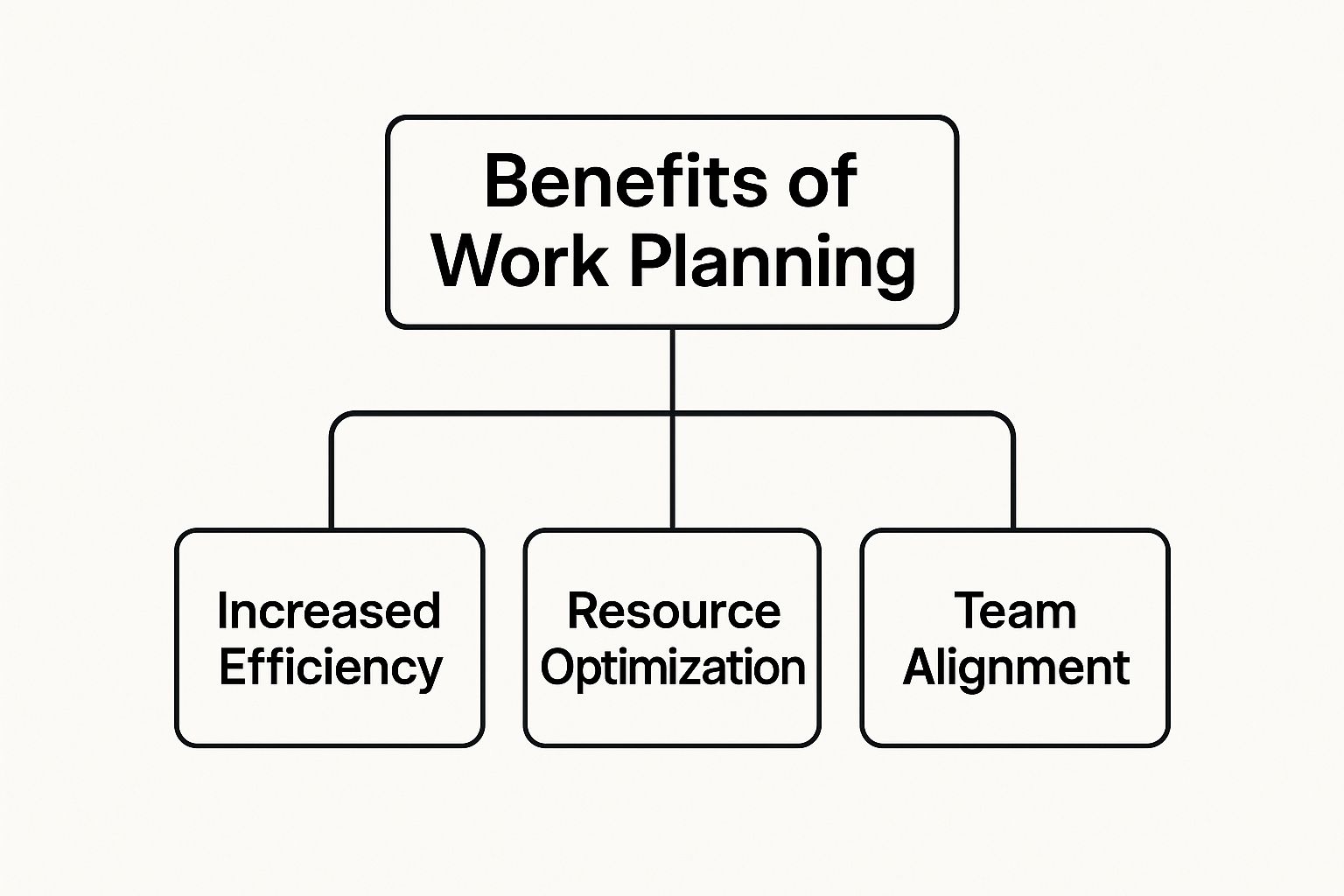Ever feel like your team is drowning in tasks, deadlines are always creeping up, and you’re constantly fighting fires instead of moving forward? It’s a frustratingly common scenario that leads to burnout and stalled projects. The good news? You can bring instant order to the chaos with a quick win. Before diving into any new project, just ask:
What are we trying to achieve?
Who is responsible for each part?
When does each piece need to be finished?
Answering these three questions is the first step in effective work planning, turning a vague idea into a clear, actionable roadmap.
End Project Chaos With Smart Work Planning

Does your team feel like they’re constantly buried under an avalanche of tasks, blowing past deadlines, and always putting out fires? It’s a common story. When you’re under pressure to deliver without a clear path forward, you get team burnout and stalled projects. This is precisely where understanding and implementing work planning becomes your most valuable tool.
A solid work plan is not a rigid, unchangeable document carved in stone; it's a flexible guide that steers your team from kickoff to completion. It’s the difference between merely hoping for a successful outcome and actively engineering it.
To really get this right, a good work plan needs to be built on a solid foundation. Let’s break down the three fundamental components that make any plan truly effective.
The Three Pillars of Effective Work Planning
Pillar | What It Involves | Why It Matters |
|---|---|---|
Goal Definition | Clearly articulating the desired outcome. This includes defining scope, setting specific deliverables, and establishing success metrics. | Without a clear destination, any path will do—and none will get you where you need to be. It aligns the team on a shared purpose. |
Resource Allocation | Assigning the right people, tools, and budget to the right tasks. It’s about more than just who does what; it’s about ensuring they have what they need to do it well. | Prevents team burnout, avoids budget overruns, and ensures you have the necessary skills and equipment to complete the work to standard. |
Timeline Management | Breaking the project into phases, setting milestones, and establishing realistic deadlines for each task. | Creates a sense of urgency and momentum. It allows you to track progress, identify potential delays early, and manage expectations with stakeholders. |
Putting these pillars into practice is what turns a good idea into a great result.
To truly banish project chaos for good, incorporating proven project management best practices is essential for delivering consistent success. What’s more, these planning principles are fundamental to much larger initiatives. You can explore different business process improvement methods to see how this kind of structured planning can scale across an entire organization.
By embracing work planning, you give your team the clarity and confidence they need to tackle any challenge that comes their way.
A 5-Step Guide to a Bulletproof Work Plan
Staring at a big, ambitious goal without a clear path forward can be paralyzing. It’s the difference between saying, "We need to boost sales," and actually having a concrete plan to make it happen. The key is to stop thinking in broad strokes and start identifying the specific components that turn a vague idea into an actionable strategy.
Here’s a step-by-step guide to move from the "what" to the "how."
Step 1: Define Clear, SMART Objectives
First things first: you have to know your destination. What does success actually look like, in no uncertain terms? Vague goals like "improve marketing" are useless. Use the SMART framework to set objectives that are Specific, Measurable, Achievable, Relevant, and Time-bound.
For example, "get more website visitors" is a weak goal. A SMART goal, on the other hand, sounds like this: "Increase organic website traffic to the company blog by 15% over the next three months." Now your team has a clear target.
Step 2: Break Down the Work into Tasks
Once your objective is locked in, break it down into smaller, manageable tasks. What individual actions does your team need to complete to hit that goal? Simply listing them out brings immediate clarity. In a tool like growlio, you can create a new project and start adding tasks under it.

Step 3: Identify Task Dependencies
Just as important, you need to identify task dependencies—those tasks that can't begin until another one is finished. For instance, you can't launch a marketing campaign (Task B) until the ad creatives are approved (Task A). Understanding these relationships from the get-go helps prevent frustrating bottlenecks later on. A core element here is establishing a smooth content creation workflow that keeps things moving efficiently.
Step 4: Allocate Resources and Assign Ownership
No plan can succeed without the right resources. This comes down to three things:
People: Who is responsible for each task? Assign owners directly in your planning tool.
Budget: How much money do you have to work with?
Tools: What software or equipment is necessary?
Pro Tip: For complex projects, use a RACI chart (Responsible, Accountable, Consulted, Informed) to clarify roles. The person Responsible does the work, while the person Accountable owns the outcome. This eliminates confusion over who has the final say.
Step 5: Set a Realistic Timeline with Milestones
A timeline isn't just one big, final deadline; it’s a series of smaller due dates for key pieces of the project. These are your milestones. Setting these keeps momentum high and ensures nothing falls through the cracks.
With these building blocks in place, you've engineered a plan to achieve your goal.
How a Marketing Agency Used Work Planning to Succeed

Theory is one thing, but seeing a work plan in action is where it all clicks. Have you ever been handed a massive project, like a full website launch, and felt that immediate wave of panic? That feeling of, "Where do I even start?" This is the exact moment where a solid plan turns chaos into a controlled, successful process.
Let's walk through a real-world example. A marketing agency we'll call 'Pixel Perfect' was hired to launch a new client website. Their objective was ambitious but crystal clear: “Launch a 10-page client website in 6 weeks.” Without a plan, you can just imagine the mess—team members scrambling, duplicating work, and almost certainly blowing past their deadline.
Instead, they took a breath and built a work plan.
From Goal to Go-Live
The first thing they did was break that big, scary goal into smaller, bite-sized task groups. This work breakdown structure gave them a bird's-eye view of everything that needed to happen, making sure no critical step was missed.
Their task groups looked something like this:
Discovery & Strategy: Client kick-off meeting, creating the sitemap, and defining content needs.
Design: Building wireframes, creating mockups, and getting client feedback.
Content Creation: Writing the copy for all 10 pages and sourcing images.
Development & QA: Actually building the site, testing every button and link, and squashing bugs.
Launch: Pushing the site live, handing it off to the client, and providing training.
Once the work was defined, they attached firm deadlines to major milestones. Key dates like "Wireframe Approval" and "Beta Launch" were locked into the calendar, giving the project a steady rhythm and making it easy to see if they were on track.
Defining Roles with a RACI Chart
Next, Pixel Perfect tackled the classic "who does what?" question. To eliminate any confusion and make sure everyone knew their role, they used a RACI chart. This simple but powerful grid spells out whether a team member is Responsible, Accountable, Consulted, or Informed for every task.
This chart from Atlassian shows exactly how it works for a "Market Research" task.

With this level of clarity, there's no guesswork. The designer knows they are responsible for the mockups, while the project manager is ultimately accountable for getting them approved.
The result? Pixel Perfect launched the website on time and under budget. The client was ecstatic, and the team avoided the burnout that always comes with chaotic projects. This story is a perfect illustration of how a simple work plan can transform a stressful, high-stakes project into an orderly success with clear ownership and a predictable outcome.
Why Smart Work Planning Is Your Competitive Advantage

Does it ever feel like your team is just running on fumes? Constantly caught in a cycle of disengagement, chasing deadlines, and missing targets? This isn't just a morale problem—it's a direct hit to your bottom line.
The good news is that smart work planning is the answer. It’s not about just managing a to-do list; it’s about strategically boosting your team's productivity and building a resilient, engaged workforce. In a competitive market, having no clear plan is a fast track to burnout and project failure. But when you get it right, work planning becomes the secret weapon that turns a team that merely survives into one that consistently thrives.
The Real Cost of Poor Planning
The link between planning and performance is crystal clear. When teams operate without a solid sense of direction, engagement takes a nosedive. As of 2024, a shocking 79% of employees are not engaged at work, highlighting a massive gap in how we manage and plan.
Consider that 70% of a team's engagement is directly tied to their manager. When leaders fall short on planning for staffing, communication, and task allocation, the ripple effect on productivity is enormous. This is precisely why 92% of companies are increasing their investment in AI to tackle these issues, with some estimating the global productivity gain from AI-enhanced work planning could be worth $4.4 trillion. You can read more in this report on workplace trends.
The data tells a simple story: poor planning isn't just sloppy; it's incredibly expensive. It leads to blown budgets, unhappy employees, and, ultimately, disappointed clients.
Mini-Case Study: Optimizing an IT Services Firm
Let’s look at a small IT services firm that was constantly juggling multiple client projects. Initially, they operated reactively, throwing technicians at whichever problem screamed the loudest. The result was pure chaos. Their most skilled technicians were stuck on minor tickets while critical system upgrades were delayed, leading to frustrated clients and burnt-out employees.
Then, they introduced a simple weekly work planning session. They started reviewing all open tickets and upcoming projects, allocating their team based on actual priority and skill sets.
High-Priority Projects: Senior techs were assigned dedicated, uninterrupted time blocks.
Routine Maintenance: Tasks were bundled and handled by junior technicians.
Client Communication: They used scheduled check-ins for better transparency.
The change was immediate. Critical projects got done faster, client satisfaction scores went up, and the team felt less stressed. This proactive approach completely changed their service delivery. A huge part of this was also improving how they started projects, a topic we cover in our guide to client onboarding best practices.
By seeing work planning as a strategic advantage, you can build a team that's more agile, productive, and genuinely happy.
Next-Level Tactics for Modern Work Planning
Have you ever crafted what felt like the perfect work plan, only to see it fall apart the moment something unexpected happens? It’s a common frustration. While basic planning gets you started, today's fast-moving projects need something more robust.
The real breakthrough comes when you stop treating your plan as a static document set in stone. Instead, think of it as a living, breathing guide that’s built to adapt to the realities of work. This means building in flexibility from the very beginning, so when things inevitably shift, you can adjust with confidence instead of scrambling.
Embrace Iterative Planning
One of the biggest shifts in modern planning is moving away from the old "set it and forget it" mentality. Today, it’s all about iterative approaches. The two most well-known frameworks for this are Waterfall and Agile.
Waterfall: This is the classic, linear method. You finish one entire phase of a project before moving on to the next, like building a house one floor at a time. It works beautifully for projects where the requirements are crystal clear and unlikely to change.
Agile: This approach breaks a large project into smaller, manageable cycles called "sprints." In each sprint, the team delivers a small, working piece of the final product. This allows for constant feedback and course correction, making it perfect for dynamic projects like software development where things can change on the fly.
Your choice really hinges on how predictable your project is. For predictable work that demands stability, Waterfall is a solid choice. But if you need to stay nimble and respond to change, Agile is the way to go.
Build in Flexibility and Automate
A great plan can bend without breaking. Building in this kind of flexibility isn't about being disorganized; it's about proactively anticipating change. A crucial part of this is getting a firm handle on your project's scope and timeline. To sharpen your skills here, it’s worth exploring different project estimation techniques.
Modern work planning also plays a vital role in figuring out what skills your team will need tomorrow. By 2030, it's estimated that 22% of current jobs will be transformed by major shifts in the labor market. With a staggering 86% of employers anticipating that AI will reshape their business, strategic planning is no longer a luxury—it's essential for aligning your team's skills with future demands. You can discover more insights in the Future of Jobs Report.
Pro Tip: Use “If-Then” Planning for Risks For every major milestone, think of one thing that could go wrong and create a simple "if-then" plan. For example: "IF the client delays feedback on the design mockups by more than two days, THEN we will immediately shift our focus to the back-end development tasks to avoid downtime." This simple trick turns potential roadblocks into manageable pivot points.
Ready to put these advanced tactics into action with a tool that makes it easy? Start your free growlio.io account and build plans that are as agile and resilient as your team.
Build Your First Flawless Work Plan Today
Feeling inspired but not quite sure where to begin? It's a common feeling. The biggest hurdle in work planning is often just taking that first step—moving from theory to a real, working plan. We've talked about why a solid plan is so critical, and now it's time to put all that knowledge into practice.
Think about turning your big goals into a live, actionable plan in just minutes. This is exactly where a dedicated tool can make all the difference. Instead of wrestling with clunky spreadsheets and chasing down updates through endless email chains, a central platform can bring everything together.
To build your first flawless work plan and truly level up your approach, utilizing practical tools like social media content planning templates can help streamline your workflow.
With a tool like growlio, you can assign a task to a team member, attach a deadline, and see its status update in real-time on a shared board. It's all in one place. This creates the kind of clarity and alignment that turns project chaos into predictable success.
Frequently Asked Questions About Work Planning
Even with the most carefully crafted plan, questions are bound to pop up. That’s a good thing! It means your team is engaged. Anticipating these common questions ahead of time can help you build a plan that’s not just detailed, but genuinely useful.
Let's walk through some of the questions that come up time and time again when teams start getting serious about work planning.
How Detailed Should My Work Plan Be?
This is the classic "how long is a piece of string?" question. The answer really depends on what you're trying to accomplish. There's no one-size-fits-all level of detail.
For a simple internal project, like updating a few web pages, a basic checklist with names and dates is probably enough. The goal is to provide clarity without creating unnecessary administrative work.
But for a major, six-month client implementation? You'll need to go much deeper. Think clear milestones, specific task dependencies (what needs to happen before something else can start?), and a solid risk assessment. The key is to start with the essentials—what, who, and when—and only add more layers of detail where they serve a real purpose in preventing confusion.
What Is the Biggest Mistake to Avoid?
If there's one pitfall to watch out for, it's this: creating the plan in a silo and then letting it gather dust. A work plan isn't a homework assignment you turn in and forget about. It's your team's living, breathing roadmap for the project.
It absolutely must be built with your team, not handed down to them. This creates ownership and ensures everyone is bought in from day one. Then, it needs to be a constant reference point, reviewed and updated regularly to match what's actually happening on the ground. A plan that isn’t updated is just a historical document.
How Do I Handle Unexpected Delays?
Let's be honest, delays happen. The best way to handle them is to expect them. Build some buffer time into your schedule, especially around the most critical or complex tasks. It’s a safety net you’ll be glad to have.
When a delay does occur, the first step is immediate and transparent communication with everyone involved. No one likes surprises.
Next, get together with the team to assess the real impact. Can you reshuffle resources to get back on track? Is there another task you can pull forward to keep momentum going? Open communication and a collaborative, problem-solving mindset are your most powerful tools here. Maintaining high standards throughout the project can also prevent many issues from cropping up in the first place, which is a core part of effective project quality management.
Ready to put these ideas into action and build plans that actually work? With growlio, you can manage tasks, track progress, and keep your team aligned in one intuitive platform. Start your free growlio.io account today and build your first flawless work plan in minutes.
